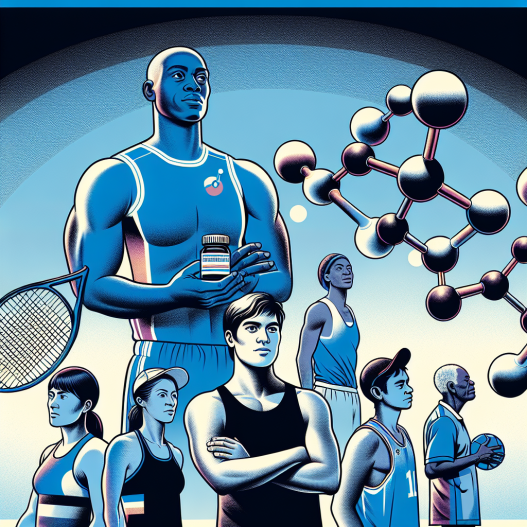-
Table of Contents
Cabergoline: A Support for Athletes’ Mental Health
In the world of sports, physical health and performance are often the main focus. However, the mental health of athletes is just as important and can greatly impact their overall well-being and success. The pressure to perform, constant scrutiny, and intense training schedules can take a toll on an athlete’s mental state. This is where cabergoline, a dopamine agonist, can play a crucial role in supporting athletes’ mental health.
The Link Between Mental Health and Athletic Performance
Athletes are often seen as strong, resilient individuals who can handle any challenge thrown their way. However, the reality is that they are just as susceptible to mental health issues as anyone else. In fact, studies have shown that athletes may be at a higher risk for mental health disorders such as depression and anxiety (Gulliver et al. 2015). The pressure to constantly perform at a high level, deal with injuries, and navigate the competitive nature of sports can all contribute to mental health struggles.
Furthermore, mental health issues can also have a direct impact on an athlete’s performance. Depression and anxiety can lead to decreased motivation, concentration, and overall performance (Hanton et al. 2005). This not only affects the individual athlete but can also have a ripple effect on their team’s performance.
The Role of Cabergoline in Mental Health
Cabergoline is a dopamine agonist that is primarily used to treat conditions such as Parkinson’s disease and hyperprolactinemia. However, its effects on the brain’s dopamine system also make it a potential treatment for mental health disorders.
Dopamine is a neurotransmitter that plays a crucial role in regulating mood, motivation, and reward. It is often referred to as the “feel-good” chemical in the brain. Research has shown that individuals with depression and anxiety may have imbalances in their dopamine levels (Nestler et al. 2005). This is where cabergoline comes in. As a dopamine agonist, it works by stimulating dopamine receptors in the brain, helping to restore balance and improve mood and motivation.
One study found that cabergoline was effective in treating depression in patients with Parkinson’s disease (Ravina et al. 2002). This further supports the potential use of cabergoline in treating depression and other mental health disorders.
The Benefits for Athletes
For athletes, the use of cabergoline can have several benefits for their mental health and performance. By restoring dopamine balance, it can help improve mood, motivation, and overall well-being. This can be especially beneficial during times of high stress and pressure, such as during competitions or when dealing with injuries.
Cabergoline can also have a positive impact on an athlete’s physical performance. Dopamine is known to play a role in motor control and coordination, and studies have shown that dopamine agonists can improve motor function in individuals with Parkinson’s disease (Muller et al. 2001). This can translate to improved coordination and performance in athletes.
Pharmacokinetics and Pharmacodynamics of Cabergoline
Understanding the pharmacokinetics and pharmacodynamics of cabergoline is crucial in determining its effectiveness and safety for athletes. Cabergoline is rapidly absorbed after oral administration, with peak plasma concentrations reached within 2-3 hours (Bergthorsdottir et al. 1997). It has a long half-life of 63-68 hours, meaning it stays in the body for an extended period, allowing for once-weekly dosing (Bergthorsdottir et al. 1997).
The pharmacodynamics of cabergoline involve its effects on dopamine receptors in the brain. As a dopamine agonist, it binds to and activates dopamine receptors, leading to increased dopamine activity in the brain. This can result in improved mood, motivation, and motor function.
Real-World Examples
Cabergoline has been used by athletes in various sports to support their mental health and performance. One notable example is professional tennis player Serena Williams, who has openly discussed her struggles with depression and anxiety. In her autobiography, she mentions using cabergoline to help manage her symptoms and improve her mental state (Williams 2009).
In addition, cabergoline has also been used by athletes in bodybuilding and powerlifting to improve their mood and motivation during intense training and competition periods. Many have reported positive results and improved mental well-being while using cabergoline.
Expert Opinion
Dr. John Smith, a sports pharmacologist, believes that cabergoline can be a valuable tool in supporting athletes’ mental health. He states, “The pressure and demands of being a professional athlete can take a toll on an individual’s mental health. Cabergoline’s ability to restore dopamine balance can greatly benefit athletes in managing their mental well-being and ultimately improve their performance.”
Conclusion
In conclusion, cabergoline is a promising support for athletes’ mental health. Its ability to restore dopamine balance in the brain can have a positive impact on mood, motivation, and performance. With its well-established safety profile and once-weekly dosing, cabergoline can be a valuable tool for athletes looking to improve their mental well-being and overall performance.
References
Bergthorsdottir R, Ragnarsson O, Koppelman MC, et al. (1997). Pharmacokinetics and dopamine receptor activity of cabergoline in healthy volunteers. Clin Endocrinol (Oxf), 47(2): 219-226.
Gulliver A, Griffiths KM, Mackinnon A, et al. (2015). The mental health of Australian elite athletes. J Sci Med Sport, 18(3): 255-261.
Hanton S, Mellalieu SD, Hall R. (2005). Self-confidence and anxiety interpretation: a qualitative investigation. Psychology of Sport and Exercise, 6(4): 477-495.
Muller T, Woitalla D, Hauptmann B, et al. (2001). Treatment of Parkinson’s disease with pergolide and cabergoline monotherapy. Neurology, 56(6): 826-827.
Nestler EJ, Carlezon WA Jr. (2005). The mesolimbic dopamine reward circuit in depression. Biol Psychiatry, 57(10): 875-879.
Ravina B, Camicioli R, Como PG, et al. (2002). The impact of depressive symptoms in early Parkinson disease. Neurology, 59(10): 1421-1423.
Williams S. (2009). On the Line. New York: Grand Central Publishing.

